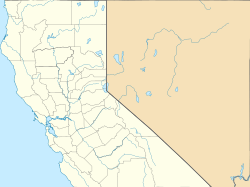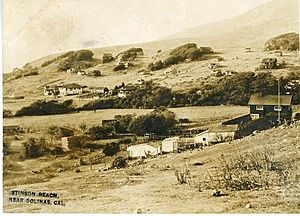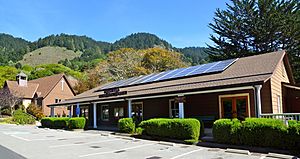Stinson Beach, California facts for kids
Quick facts for kids
Stinson Beach
|
|
|---|---|
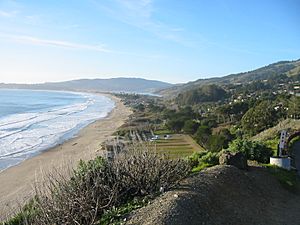
Stinson Beach
|
|
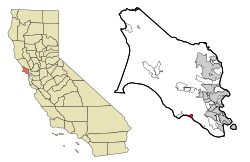
Location in Marin County and the state of California
|
|
| Country | United States |
| State | California |
| County | Marin |
| Area | |
| • Total | 0.892 sq mi (2.31 km2) |
| • Land | 0.892 sq mi (2.31 km2) |
| • Water | 0.0 sq mi (0 km2) 0.0% |
| Elevation | 26 ft (8 m) |
| Population
(2020)
|
|
| • Total | 541 |
| • Density | 606.5/sq mi (234.2/km2) |
| Time zone | UTC−8 (PST) |
| • Summer (DST) | UTC−7 (PDT) |
| ZIP Code |
94970
|
| Area codes | 415/628 |
| FIPS code | 06-74172 |
| GNIS feature ID | 235489 |
Stinson Beach is a small town in Marin County, California. It is located on the west coast of the United States. The town sits across a channel from Bolinas, near the Bolinas Lagoon. Stinson Beach is about 26 feet (8 m) above sea level. In 2020, about 541 people lived there.
Stinson Beach is a popular spot for day trips. It is about a 35-minute drive from the Golden Gate Bridge. You can get there by taking California State Route 1. The town is close to famous places like Muir Woods National Monument, Muir Beach, and Mount Tamalpais.
Many visitors come by car. However, there is also a bus service that connects Stinson Beach to Marin City. You can also reach the town by hiking trails from Mount Tamalpais. The beach here is known for being very clean and sandy. This is different from the nearby beach in Bolinas, which has more rocks.
Contents
History of Stinson Beach
The land where Stinson Beach is now was bought by Nathan H. Stinson in 1866.
From Willow Camp to Stinson Beach
In 1870, the first road was built along the Pacific coast from Sausalito. A small tent village started among the willow trees on the beach. This led to the town's first name, Willow Camp. In 1896, the Mt. Tamalpais & Muir Woods Railway opened. This made Willow Camp easier to reach. Visitors could ride the train and then hike or take a stagecoach to the beach.
After the 1906 San Francisco earthquake, many people moved to the area. They built some of the first businesses in the town. In 1916, the town was officially named Stinson Beach. This was to honor Rose and Nathan Stinson, who owned a lot of land there. The first post office also opened in 1916.
Beach Ownership and Local News
In 1939, Marin County bought the beach. It was then given to the state of California in 1950. Finally, in 1977, it became part of the National Park Service.
In 1963, Merrill and Joann Grohman started the Pacific Sun newspaper. This was the only newspaper for Stinson Beach. It started in the back of a grocery store called Bill's Superette. The newspaper later moved to San Rafael in 1966.
Shark Encounters and Safety
The waters off Stinson Beach are part of an area called the Red Triangle. This area has seen a higher number of shark attacks. In 2002, a surfer was injured by a great white shark while surfing. The surfer survived. Another surfer was also injured by a great white shark in 1998.
To keep people safe, Marin County put up 12 tsunami warning signs along the Stinson Beach shoreline in 2012. These signs help explain the risks to people visiting the beach.
Geography and Climate
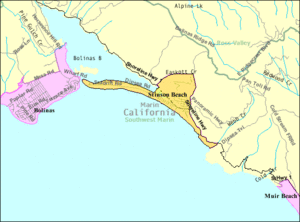
Stinson Beach is in the southern part of Marin County. It is located at 37°54′02″N 122°38′40″W / 37.90056°N 122.64444°W. The town is between Bolinas and Muir Beach. It is about 15 miles (24 km) northwest of Sausalito and 20 miles (32 km) northwest of San Francisco.
The total land area of Stinson Beach is about 0.89 square miles (2.31 km2). There is no water area within the town's official boundaries.
Weather in Stinson Beach
Stinson Beach has a warm-summer Mediterranean climate. This means it has warm, dry summers and mild, wet winters. In summer, afternoons are often cool and windy. This is because winds blow in from the cold ocean. The ocean water temperature is usually in the low to mid 50s F all year. Stinson Beach gets more rain than other coastal cities in the San Francisco Bay Area. It receives about 1,034.70 mm (40.736 in) of rain each year.
| Climate data for Stinson Beach (Bolinas), California | |||||||||||||
|---|---|---|---|---|---|---|---|---|---|---|---|---|---|
| Month | Jan | Feb | Mar | Apr | May | Jun | Jul | Aug | Sep | Oct | Nov | Dec | Year |
| Mean daily maximum °F (°C) | 55.2 (12.9) |
59.6 (15.3) |
63.0 (17.2) |
66.1 (18.9) |
69.8 (21.0) |
74.1 (23.4) |
76.7 (24.8) |
77.1 (25.1) |
77.0 (25.0) |
72.1 (22.3) |
62.6 (17.0) |
55.3 (12.9) |
67.4 (19.7) |
| Daily mean °F (°C) | 48.8 (9.3) |
52.2 (11.2) |
54.5 (12.5) |
56.8 (13.8) |
55.8 (13.2) |
59.9 (15.5) |
65.4 (18.6) |
65.8 (18.8) |
65.4 (18.6) |
61.7 (16.5) |
54.8 (12.7) |
49.1 (9.5) |
57.5 (14.2) |
| Mean daily minimum °F (°C) | 42.3 (5.7) |
44.7 (7.1) |
45.9 (7.7) |
47.4 (8.6) |
50.0 (10.0) |
52.7 (11.5) |
54.0 (12.2) |
54.4 (12.4) |
53.8 (12.1) |
51.3 (10.7) |
47.0 (8.3) |
42.9 (6.1) |
48.9 (9.4) |
| Average precipitation inches (mm) | 7.7 (200) |
7.8 (200) |
5.5 (140) |
2.2 (56) |
1.3 (33) |
0.3 (7.6) |
0 (0) |
0.1 (2.5) |
0.3 (7.6) |
1.9 (48) |
5.3 (130) |
8.3 (210) |
40.7 (1,034.7) |
| Source: Bestplaces.net | |||||||||||||
People in Stinson Beach
In 2010, the population of Stinson Beach was 632 people. Most residents, about 92.1%, were White. About 5.2% of the population was Hispanic or Latino.
The average age of people in Stinson Beach was 54.4 years old. About 12% of the population was under 18 years old. Many people, 44%, were between 45 and 64 years old. About 21.4% were 65 or older.
Most homes in Stinson Beach were owned by the people living in them (61.7%). The rest were rented (38.3%).
Education
Stinson Beach is part of several school districts. These include the Bolinas-Stinson Union School District, the Tamalpais Union High School District, and the Marin Community College District.
Younger students (kindergarten to 2nd grade) go to Stinson Beach School. Older elementary students (grades 3-8) attend Bolinas School. For high school, students from Stinson Beach go to Tamalpais High School in Mill Valley.
Community Groups
The Stinson Beach Village Association was started in 1976. This group helps represent the town's interests. The current president is Michael Matthews.
The Stinson Beach Community Center is an important place in town. It includes the Fire House, the Community Center building, and the Chapel. The land for the center was given by the FitzHenrys and the Stinson families.
Fun Things to Do Nearby
There are many great places to visit and explore near Stinson Beach:
- Audubon Canyon Ranch
- Golden Gate National Recreation Area
- Mount Tamalpais State Park
- Point Reyes National Seashore
Yearly Events
Stinson Beach hosts a few exciting events each year.
Dipsea Race
On the second Sunday of June, the town is the finish line for the Dipsea Race. This is the second-oldest footrace in the United States.
Mount Tamalpais Hill Climb
In early fall, the California Road Club holds its Mount Tamalpais Hill Climb. This is one of the oldest bicycle races in the West. About 400 bicyclists compete in this 12.5-mile (20.1 km) road race. It goes from Stinson Beach to the West summit of Mount Tamalpais.
Cuisine on the Green
"Cuisine on the Green" is a yearly event held in May. It takes place in the town's central park, the Village Green. Local restaurants and shops set up booths. They sell food, crafts, clothing, art, and other unique items. Local performers often play music on a small stage. This event helps raise money for the Stinson Beach Community Center.
Tug-of-War
Every year on July 4th, there is a "tug-of-war" game. It happens across the water that separates Stinson Beach and Bolinas. Thirty women from each town pull against each other. Then, 30 men from each town take their turn. It's a fun, friendly competition that brings the communities together.
Famous People from Stinson Beach
Many interesting people have lived in or been connected to Stinson Beach. Here are a few:
- Rafael Garcia [1836–1846], the first person to settle near Bolinas Lagoon.
- Ramona Garcia Briones (1793/4–June 23, 1901), who received a large land grant in 1846. She was believed to be the oldest woman in California when she passed away at 107.
- Captain Isaac Morgan [c. 1851–?], who bought land that later became Stinson Beach. He grew apples, cut wood, and had a dairy farm.
- Nathan and Rose Stinson [1870s–?], who started the first campground at Willow Camp. The town was later named after them.
- William Kent (1864–1928), a U.S. Congressman. He donated the land for the Muir Woods National Monument. He also owned the beach that became Seadrift.
- Mildred Sadler (1905–2004), who was the Principal of Stinson Beach School for many years (1926–1967).
- Elmer Collett (1966–present), a former professional football player.
- Peter Bishop Allen (1943–2004), a sculptor of marine animals. He was also an Assistant Chief for the Stinson Beach Fire Department.
- Steve Miller (1960s–1970s), a famous musician.
- Jerry Garcia (1970s), a musician from the band Grateful Dead.
- Carolyn Garcia, also known as Mountain Girl (1970s), a member of the Merry Pranksters and wife of Jerry Garcia.
- Klaus Kinski, a well-known actor.
Stinson Beach in Pop Culture
Stinson Beach has been featured in movies, TV shows, and songs.
Movies and TV
Several movies have been filmed in or set in Stinson Beach:
- Play It Again, Sam
- The Fog
- Memoirs of an Invisible Man
- The Invisible Man (2020 film)
- Basic Instinct
- On The Edge
- Shoot The Moon
- The Crazy-Quilt (1966 John Korty Film)
- America Is Still the Place
The town was also mentioned in an episode of the TV show M*A*S*H.
Music and Books
George Frayne, from the band Commander Cody and His Lost Planet Airmen, wrote a song about Stinson Beach called "Midnight on The Strand."
The poet Garrison Keillor wrote a poem about Stinson Beach. In his book We Are Still Married: Stories and Letters, he shares how thinking of the beach helps him sleep.
The poet Robert Duncan wrote his important collection Opening the Field at a house in Stinson Beach.
Janis Joplin's ashes were scattered along this beach and in the Pacific Ocean.
Author Danielle Steel writes about Stinson Beach in her novel One Day at a Time (Dell, 2009, ISBN: 978-0-440-24333-5).
Images for kids
See also
 In Spanish: Stinson Beach para niños
In Spanish: Stinson Beach para niños


